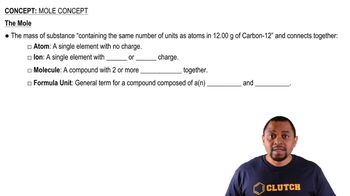Textbook Question
Determine the empirical formula of each of the following compounds if a sample contains c. 87.5% N and 12.5% H by mass.
 Verified step by step guidance
Verified step by step guidance



Determine the empirical formula of each of the following compounds if a sample contains c. 87.5% N and 12.5% H by mass.
Determine the empirical formulas of the compounds with the following compositions by mass: a. 10.4% C, 27.8% S, and 61.7% Cl
Determine the empirical formulas of the compounds with the following compositions by mass: b. 21.7% C, 9.6% O, and 68.7% F
Determine the empirical formulas of the compounds with the following compositions by mass: c. 62.1% C, 5.21% H, 12.1% N, and the remainder O
A compound whose empirical formula is XF3 consists of 65% F by mass. What is the atomic mass of X?
The compound XCl4 contains 75.0% Cl by mass. What is the element X?